You are using an out of date browser. It may not display this or other websites correctly.
You should upgrade or use an alternative browser.
You should upgrade or use an alternative browser.
Unprecedented Rainfall and Major Flooding Around the World
- Thread starter Third_Density_Resident
- Start date
Latess from China, From bad to worse. Check the video with the link.
Evacuation underway in China’s Inner Mongolia after torrential rain causes two dams to collapse
Evacuation underway in China’s Inner Mongolia after torrential rain causes two dams to collapse
More dam collapse in China
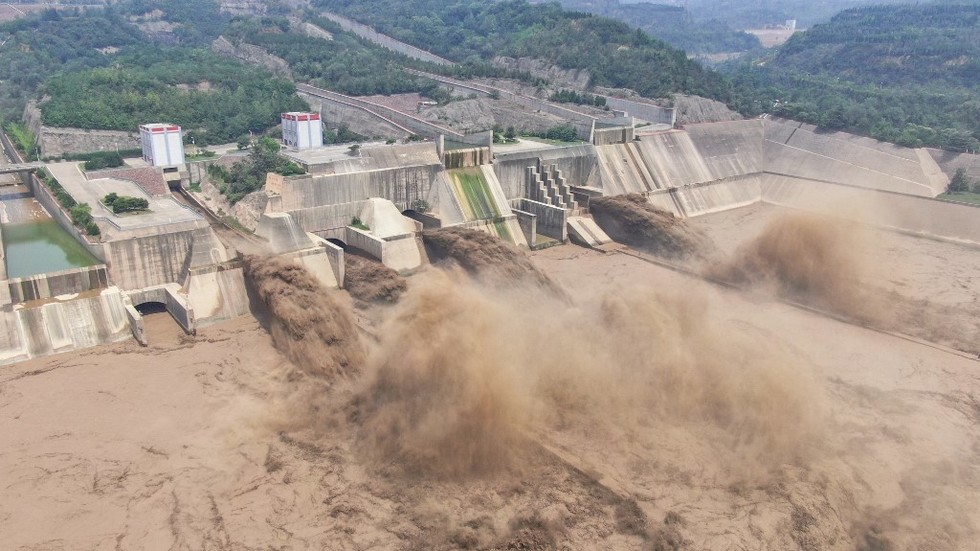
 www.rt.com
www.rt.com
Get short URL
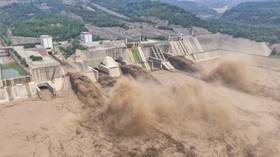
FILE PHOTO: An aerial photo shows water being released from the Xiaolangdi Reservoir Dam in Luoyang in China's central Henan province on July 5, 2021 © AFP

As floods wreak havoc on China’s Henan province, the military has been dispatched to prevent a dam from collapsing. Floodwaters have already washed away two dams elsewhere in China this week.
Heavy rain and rising floodwaters overwhelmed Henan province in central China on Tuesday, flooding subway stations in the city of Zhengzhou and washing vehicles off the road. By Tuesday night, however, the nearby city of Luoyang and its seven million inhabitants faced an even more sobering threat: the collapse of the Yihetan Dam, which holds back the waters of the Yellow River from the city.
ALSO ON RT.COMChinese subway passengers trapped by rising floodwaters as torrential rain pounds Henan province (VIDEOS)
China’s People’s Liberation Army (PLA) announced on Tuesday that “a 20-meter breach” occurred in the dam, and that the entire structure “could collapse at any time.” In a post to Weibo, a Chinese social media platform, the PLA said that troops had been sent to blast the dam and divert floodwaters.
Photos shared by the Shanghai Daily news site show some of what it reported as “20,000 soldiers and armed policemen” deployed to Yihetan and another dam in the province to prevent further flooding.
Flooding is common during China’s rainy season, yet the country’s rapid development in recent decades has seen a glut of dam building, and as a result rivers that once drained into flood plains have been diverted.
Two dams collapsed on Monday in China’s Inner Mongolia, flooding more than 20,000 hectares of land and washing away dozens of bridges and culverts. Some 16,000 locals were affected, Global Times reported, with many forced to evacuate.
At least 12 people were killed and around 100,000 evacuated in Zhengzhou City, the state-owned People's Daily reported on Tuesday night.

Amid rain and floods, China sends military to stop 'imminent' dam collapse in Henan
As floods wreak havoc on China’s Henan province, the military has been dispatched to prevent a dam from collapsing. Floodwaters have already washed away two dams elsewhere in China this week.
Amid rain and floods, China sends military to stop 'imminent' dam collapse in Henan
20 Jul, 2021 20:18Get short URL

FILE PHOTO: An aerial photo shows water being released from the Xiaolangdi Reservoir Dam in Luoyang in China's central Henan province on July 5, 2021 © AFP
As floods wreak havoc on China’s Henan province, the military has been dispatched to prevent a dam from collapsing. Floodwaters have already washed away two dams elsewhere in China this week.
Heavy rain and rising floodwaters overwhelmed Henan province in central China on Tuesday, flooding subway stations in the city of Zhengzhou and washing vehicles off the road. By Tuesday night, however, the nearby city of Luoyang and its seven million inhabitants faced an even more sobering threat: the collapse of the Yihetan Dam, which holds back the waters of the Yellow River from the city.
ALSO ON RT.COMChinese subway passengers trapped by rising floodwaters as torrential rain pounds Henan province (VIDEOS)
China’s People’s Liberation Army (PLA) announced on Tuesday that “a 20-meter breach” occurred in the dam, and that the entire structure “could collapse at any time.” In a post to Weibo, a Chinese social media platform, the PLA said that troops had been sent to blast the dam and divert floodwaters.
Photos shared by the Shanghai Daily news site show some of what it reported as “20,000 soldiers and armed policemen” deployed to Yihetan and another dam in the province to prevent further flooding.
Flooding is common during China’s rainy season, yet the country’s rapid development in recent decades has seen a glut of dam building, and as a result rivers that once drained into flood plains have been diverted.
Two dams collapsed on Monday in China’s Inner Mongolia, flooding more than 20,000 hectares of land and washing away dozens of bridges and culverts. Some 16,000 locals were affected, Global Times reported, with many forced to evacuate.
At least 12 people were killed and around 100,000 evacuated in Zhengzhou City, the state-owned People's Daily reported on Tuesday night.
Ocean
The Living Force
This is tragic
Jennifer Zeng
In the past several days, some parts in China have experienced “once in a thousand years” heavy rainfall, and terrible videos and images were circulated on the internet. Contrary to these, is how quiet, how “positive” the CCP’s media, as well as some mainstream media in the West have been about this. Today I have to tell you about the contrast. Again, the content and videos you are going to see are unique to me, and you won’t see these in the mainstream media.
Jennifer Zeng
In the past several days, some parts in China have experienced “once in a thousand years” heavy rainfall, and terrible videos and images were circulated on the internet. Contrary to these, is how quiet, how “positive” the CCP’s media, as well as some mainstream media in the West have been about this. Today I have to tell you about the contrast. Again, the content and videos you are going to see are unique to me, and you won’t see these in the mainstream media.
Metrist
The Living Force
A potential landslide and tsunami threat is being monitored in Alaska. Whittier, a city in one bldg., is threatened by a 30ft. wave, but the threat has recently been downgraded to 7ft.
The mountains are steep, and there are a lot of waterfalls and glaciers.
With natural disasters happening all over, they might just be cautious, but it is also a tourist destination so....
The mountains are steep, and there are a lot of waterfalls and glaciers.
With natural disasters happening all over, they might just be cautious, but it is also a tourist destination so....
XPan
The Living Force
This is tragic
Jennifer Zeng
In the past several days, some parts in China have experienced “once in a thousand years” heavy rainfall, and terrible videos and images were circulated on the internet. Contrary to these, is how quiet, how “positive” the CCP’s media, as well as some mainstream media in the West have been about this. Today I have to tell you about the contrast. Again, the content and videos you are going to see are unique to me, and you won’t see these in the mainstream media.
Awful and disheartening images and scenes. But why are the drivers in front of the tunnel driving deeper into it, while the water is pouring in everywhere ? What kind of conform reaction is that - i really don’t understand ! (In the last video)
And the lady reading the official response of the gov to the disaster - sounded like a somewhat milder version of North Korean news anchor. Same resonance in their type of speaking… hurrrk.
Metrist
The Living Force
I found this link while searching for satellite imagery during the flooding in Europe.
It says warnings were sent out, and that they arrived too late, or were ignored. So, the science was able to capture this threat potential and relay it.
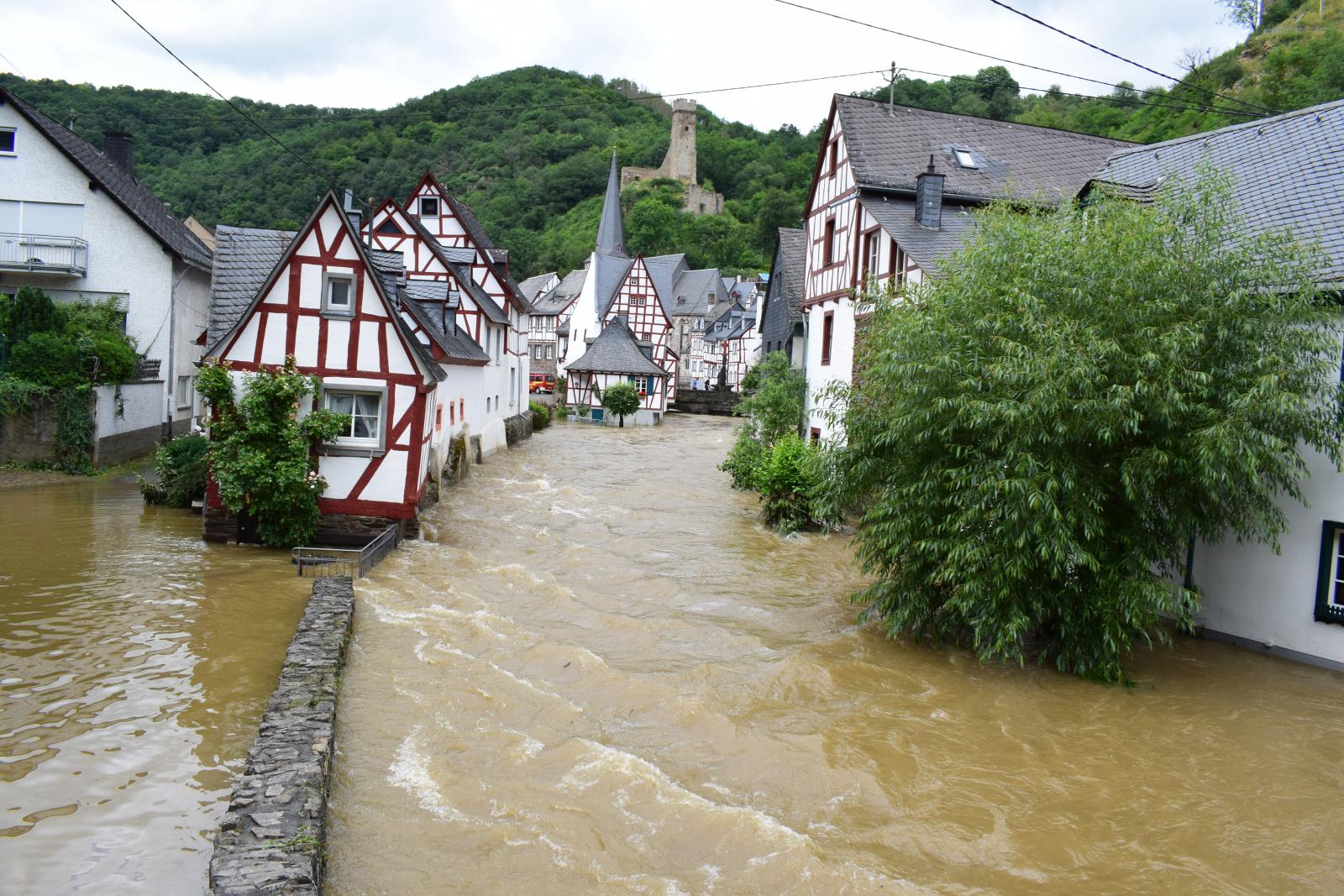
 www.netweather.tv
www.netweather.tv
It says warnings were sent out, and that they arrived too late, or were ignored. So, the science was able to capture this threat potential and relay it.

Europe floods July 2021: What caused them and why people were caught out
The impacts of the catastrophic flooding during the week across parts of western Germany, eastern Belgium and the Netherlands have been shocking to see. This blog looks at the causes.
#Maltempo, since this morning heavy rains have affected the province of #Varese : carried out by #vigilidelfuoco 40 interventions for flooding and landslides between the areas of Gavirate and Luvinate, in Brusimpiano a stream overflowed carrying debris against a house #28luglio
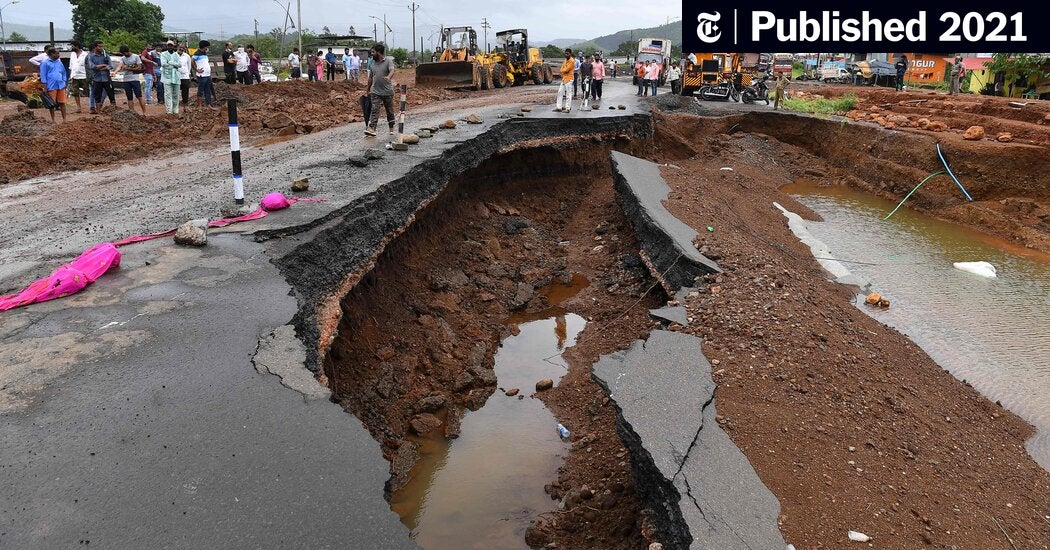
 www.nytimes.com
Every monsoon season poses risks to the country, but this one is shaping up as especially destructive as climate change turbocharges rainfall.
www.nytimes.com
Every monsoon season poses risks to the country, but this one is shaping up as especially destructive as climate change turbocharges rainfall.
Updated July 27, 2021
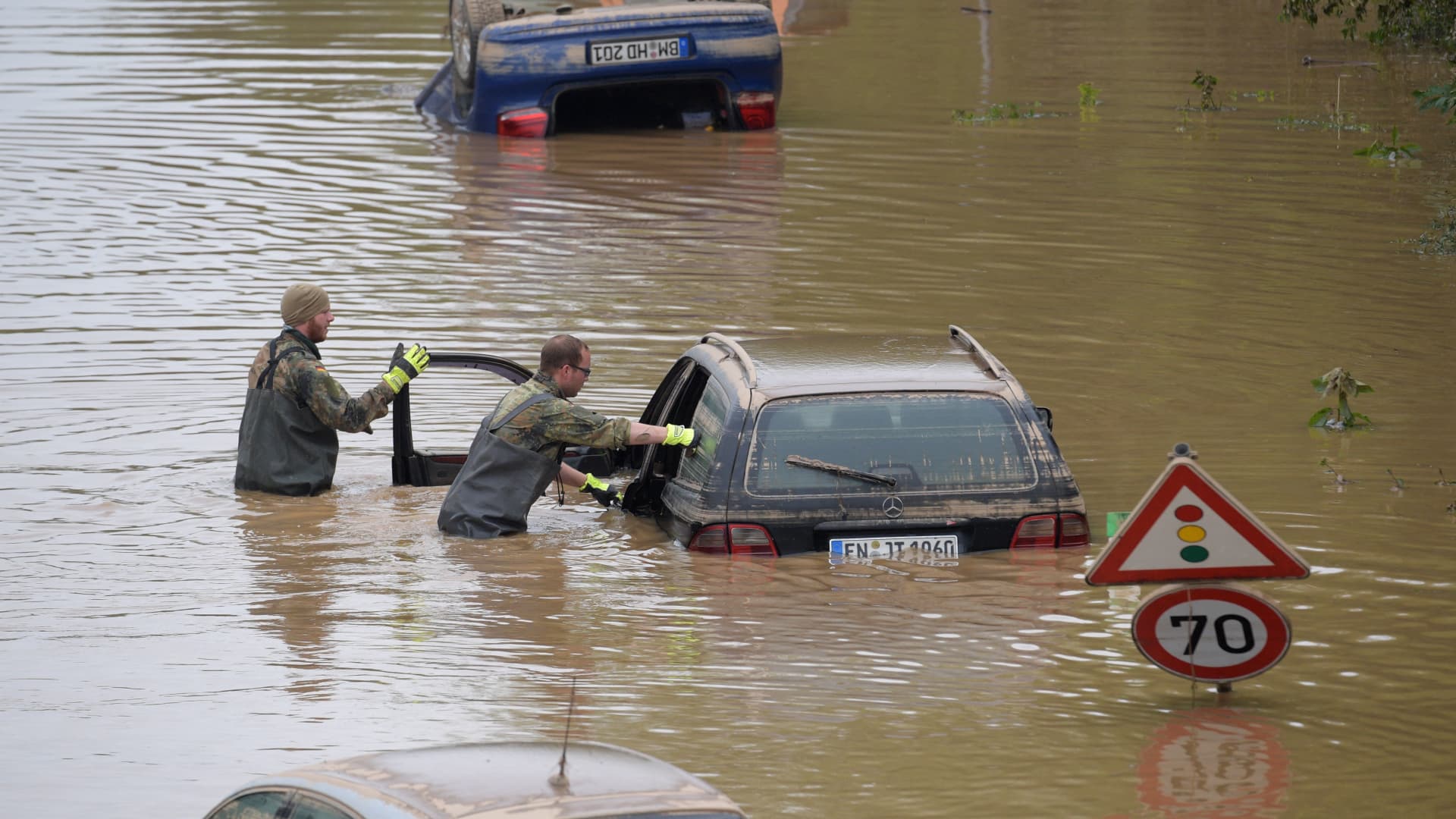
 www.cnbc.com
Updated Mon, Jul 26 20219:57 PM EDT
www.cnbc.com
Updated Mon, Jul 26 20219:57 PM EDT

Scores Die in India as Monsoon Rains Swamp Towns and Send Boulders Tumbling (Published 2021)
Every monsoon season poses risks to the country, but this one is shaping up as especially destructive as climate change turbocharges rainfall.
Updated July 27, 2021
NEW DELHI — Within seconds, the scenic mountain valley resembled a war zone.
“Guys, we have to run!” said a man filming the devastation unfolding in his hillside town in northern India on Sunday, as a landslide set off by incessant monsoon rains sent heavy rocks tumbling down a steep slope.
At least nine people were killed when a boulder struck their vehicle. Their deaths added to a toll of at least 164, with 100 reported missing, on the country’s western coast, where heavy rains have deluged entire towns and villages.
India’s monsoons have always arrived with fury. But the scenes of death and destruction playing out in the country are yet another reminder of the urgency of climate change, experts say. A warming climate means extreme rainfall in many parts of the world, scientists have said.
Record rainfalls in central China and Western Europe have killed scores in recent weeks and displaced many others. On Saturday, the authorities in the Philippines evacuated thousands of residents after a tropical storm flooded the capital, Manila, and nearby provinces.
In the last few months, India, a nation of 1.4 billion people, has experienced two powerful cyclones and deadly floods in the Himalayas. It has also suffered through extreme temperatures, including a heat wave that killed thousands of people.
Scientists have warned that extreme weather is likely to become more common and more intense in the coming decades as sea levels rise and the Indian Ocean becomes warmer.
“The threat of rising sea level is something that we often overlook and underestimate,” said Roxy Koll, a climate scientist in India and one of the authors of a study released last week on how a warming climate will make heat waves and cyclones more frequent and more ferocious in India.
“Climate change is a threat multiplier,” the authors, Mr. Koll and Chirag Dhara, an assistant professor at Krea University in the southeastern state of Andhra Pradesh, wrote in the study. “In the absence of rapid, informed and far-reaching mitigation and adaptation measures, the effects of climate change are likely to pose profound challenges to sustaining the country’s rapid economic growth.”
India’s agrarian economy depends heavily on monsoon rain. Too little means a drought, and too much can cause catastrophic flooding.
Extreme rainfall washes away fertile topsoil, while droughts deplete groundwater reserves that have been declining rapidly in many parts of the country for years. Together, they have caused misery and death on India’s farms.
Over the weekend, heavy rains continued to pummel the western state of Maharashtra, where rescue workers struggled to reach areas cut off by flooding and landslides. Workers dug through mud and transported people by boat in areas where the water had reached the tops of houses.
Nearly 300,000 people have been evacuated and thousands were staying in relief camps, state officials said on Monday. There have been more than 250 deaths in the state related to the monsoon season since it began last month.
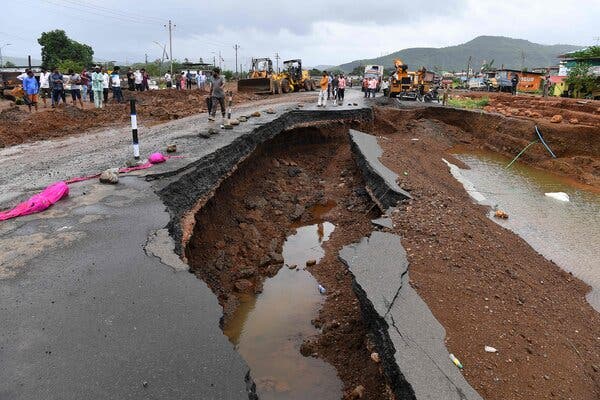
A section of highway partly collapsed after heavy rain in Mahad, in the state of Maharashtra, on Saturday. Credit...Indranil Mukherjee/Agence France-Presse — Getty Images
Uddhav Thackeray, Maharashtra’s top official, said on Twitter that his helicopter could not land because of “low visibility” as he tried to visit flood-affected areas in the district of Satara.
India’s meteorological department forecast “fairly widespread to widespread rainfall” for the next two days across northern, eastern and western parts of the country.
About 1,000 miles from Maharashtra, in the northern state of Himachal Pradesh, officials said on Monday that at least 100 people remained stranded after the landslide on the mountain slope, and that rescue efforts were continuing.
Video footage showed heavy rocks knocking down a metal bridge. The boulders pounded vehicles and fell into a nearby river, making giant splashes and sounds akin to exploding bombs.
“The accident caused by landslide in Kinnaur, Himachal Pradesh, is very sad,” Prime Minister Narendra Modi said on Twitter. “My heartfelt condolences to the families of those who lost their lives.”
Mr. Modi announced compensation of 200,000 rupees, or more than $2,500, to the families of those who died.

Global shipping industry disrupted again, this time by floods in Europe and China
The floods in China and Europe are yet "another body blow" for global supply chains, the CEO of a shipping firm told CNBC on Monday.
The floods in China and Europe are yet “another body blow” for global supply chains, the CEO of a shipping firm told CNBC on Monday.
- Shipping has already seen massive disruptions this year like the Ever Given running aground in the Suez Canal and delays stemming from an uptick in Covid cases near ports in southern China.
- The floods in China and Europe are yet “another body blow” for global supply chains, the CEO of a shipping firm told CNBC on Monday.
“Rarely does a week go past without something new,” says Tim Huxley, CEO of Mandarin Shipping.
Shipping has already seen massive disruptions this year. As parts of the world rebounded from the pandemic, increased spending led to a shortfall of containers, creating delays and driving up prices.
Then in April, one of the world’s largest container ships became wedged in the Suez Canal, halting traffic for nearly a week. The waterway is one of the busiest in the world, with about 12% of trade passing through it.
In June, an uptick of Covid cases in southern China caused more delays at ports in the region, again jacking up shipping prices.
‘Broken railway links’ caused by floods in Europe
Heavy rainfall and flooding have devastated parts of western Europe. Some of the most severe flooding happened in Germany and Belgium. Parts of Switzerland, Luxembourg and the Netherlands have been affected as well.
“This is really going to disrupt the supply chain because the railway links have all been broken,” Huxley told CNBC’s “Squawk Box Asia.”
He said that includes railways coming from the Czech Republic and Slovakia into the German ports of Rotterdam and Hamburg, which have been “seriously disrupted.”
“And so that’s going to delay cargo movements in and out,” he said. “It’s gonna really disrupt the industry.”
Huxley pointed to Thyssenkrupp, noting the German steel making giant could not get raw materials due to the flooding.
“That ultimately will have a knock on effect on industries such as the motor industry, domestic appliances and things like that,” he said.
S&P Global Platts reported, citing a letter to customers, Thyssenkrupp declared force majeure on July 16. A force majeure event occurs when unforeseeable circumstances, such as natural catastrophes, prevent one party from fulfilling its contractual duties, absolving them from penalties.
A source at the firm’s mills told S&P Global Platts that parts of the railway in Hagen are “missing,” adding it’s even more difficult than before to get trucks for delivery. Hagen is a city in Western Germany that is among the worst-hit by the floods.
Flooding in landlocked Henan disrupting supply of wheat, coal
Meanwhile, the disruption caused by the flooding in the Chinese province of Henan is made worse by the fact that the province is landlocked, said Huxley.
The disruption of railways is, again, going to cause a “big impact,” he said.
“Obviously, that will have an impact on shipping, that will force shipping rates up,” Huxley said.
The distribution of wheat and coal has been affected, according to Huxley, who pointed out that Henan is the “bread basket” of China and has produced 38 million tons of wheat this summer.
Cleanup operations continued Saturday in the Afghan village of Merdesh after flash flooding struck a remote area in the country's mountainous northeast, killing at least 150 people. (July 31)
Taliban say flooding kills 150 in Afghanistan
Taliban say flooding kills 150 in Afghanistan
Another landslide at England's Jurassic Coast.
Aug 3, 2021
A section of cliff has collapsed cutting off a stretch of beach on the Jurassic Coast.The large rock fall, which happened on Saturday, blocked off the beach between Eype and Seatown in Dorset.Dorset Council warned the fall had "not yet settled" and the ground inland was "relaxing with more cracks opening up".The authority has urged people to obey the safety signs and not cross the cordons or climb on the debris on the beach.A stretch of the South West Coast Path, which runs along the top of the credit: https://www.bbc.com/news/uk-england-d...
Snip: Photos Analyses with Comparisons
City in India
Major flooding washed away homes, roads and bridges along North Korea’s east coast in recent days, according to NK News analysis of satellite imagery, as DPRK state television said that some areas have already seen over 580 millimeters of rain (23 inches).
The floods come on the heels of a monthlong heat wave and drought in July that state media said damaged crops and may threaten upcoming harvests. North Korean leader Kim Jong Un admitted in June that the country was facing a “food crisis” after suffering typhoon damage last year.
State media has recently reported on widespread efforts to reinforce shores and riverbanks ahead of what it says could be multiple typhoon events in August, but it has yet to report on the latest damages.
The latest flooding occurred in small towns along major rivers in North and South Hamgyong provinces from Aug. 1-3, Planet Labs satellite imagery shows.
City in India
Trending content
-
-
-
-
Thread 'Coronavirus Pandemic: Apocalypse Now! Or exaggerated scare story?'
- wanderingthomas
Replies: 30K
